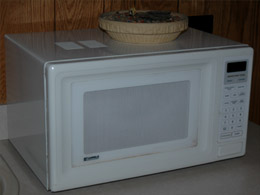Microwave Ovens
 | The microwave radiation of microwave ovens and some radar applications is produced by a device called a magnetron. Modern microwave overns operate at the frequency 2,450 MHz. |
By federal regulation, microwave ovens are limited to 5 milliwatts (mW) of microwave radiation per square centimeter at approximately 2 inches from the oven surface. This limit is far below the level known to harm people. The microwave radiation would be expected to drop off according to the inverse square law, so at 20 inches it would be down by about a factor of 100.
Considering the frequency of 2,450 MHz, the wavelength of microwave oven radiation is about 12 cm and the quantum energy of a microwave photon is about 1 x 10-5 eV. The radiation interaction at such energies is limited to the production of molecular rotation and torsion. The average thermal energy at 20°C is about 1/40 eV, so any ordered rotational motion created by the microwave interaction is quickly randomized by collisions with molecules of kinetic energy 2500 times greater than the microwave photon energy provided. So the net result of microwave interaction in microwave ovens is to heat the material in the oven.
Even though you can see into the microwave oven when your food is cooking, the microwaves are effectively blocked from getting out into the room because the holes in the metal screen on the microwave oven door are about 1 mm in diameter compared to a 120 mm wavelength for the microwaves. The wavelength of the microwaves is about 120 times the size of the holes, and can't "see" the holes to get out. This is an application of the fact that you cannot image anything that is smaller than the wavelength of the radiation you use to image it. You can see through the holes because at 500 nm wavelength, the light wavelength is about 2000 times smaller than the holes.
| Transport of energy by electromagnetic waves |
Wave concepts
Electromagnetic wave concepts
Electromagnetic spectrum
| HyperPhysics*****Electricity and Magnetism | R Nave |